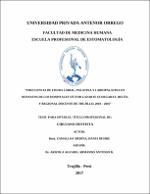| dc.contributor.advisor | Arizola Aguado, Armando Antonio B. | |
| dc.contributor.author | Zamalloa Medina, Hania Desire | |
| dc.creator | Zamalloa Medina, Hania Desire | |
| dc.date.accessioned | 2017-11-28T17:01:39Z | |
| dc.date.available | 2017-11-28T17:01:39Z | |
| dc.date.issued | 2017 | |
| dc.identifier.uri | https://hdl.handle.net/20.500.12759/3367 | |
| dc.description.abstract | La presente investigación realizada en los hospitales Víctor Lazarte Echegaray, Belén y
Regional Docente de Trujillo, entre los años 2010 al 2017; es un estudio retrospectivo; que
tuvo como finalidad establecer la frecuencia de fisura labial, palatina y labiopalatina en
neonatos y su relación según la localización anatómica y sexo de cada paciente.
Los datos fueron tomados de las historias clínicas de os archivos de la Oficina de
Estadística de cada hospital. Se encontró que la fisura palatina presento la mayor frecuencia
(49%), seguido y no por mucho de la fisura labiopalatina (48%), por último tenemos a la
fisura labial (3%).
La frecuencia de fisuras que predominaron en relación a la localización anatómica fue la
fisura labial izquierda con 71.4%, en fisura palatina la mayor frecuencia es central con un
46.6% y en Fisura Labiopalatina la mayor es unilateral izquierda con un 71.1%.
Al comparar entre ambos sexos, la fisura palatina labial en mujeres es de 4.7%, la fisura
palatina es de 55.7% y la fisura Labiopalatina es de un 39.6%; respecto al grupo de hombre
la fisura labial es de 1.5%, la fisura palatina es de 44.4% y la fisura labiopalatina es de
54.1%.
Al agrupar sexo y localización anatómica, se encontró que la fisura Labiopalatina es más
frecuente en hombres y la fisura palatina es más frecuente en mujeres. Lo anteriormente
mencionado es corroborado por la prueba Chi-cuadrado que nos da un valor de p menor
que 0.05 (p = 0.045) es decir existe relación entre el tipo de fisura y el sexo.
Las Tasa de Prevalencia se calcularon por cada 1 000 nacidos vivos, la tasa de prevalencia
de fisura labial es de 0.15, fisura palatina es de 2.55 y fisura labiopalatina es de 2.46 por
cada 1000 neonatos nacidos vivos en el periodo de estudio. El resultado general en cuanto
a la prevalencia, fue de 5.16% por cada 1000 neonatos nacidos vivos (Tabla de N° 5). | es_PE |
| dc.description.abstract | The present research carried out in the hospitals Víctor Lazarte Echegaray, Belén and
Regional Teacher of Trujillo, between the years 2010 to 2017; is a retrospective study;
which had as purpose to establish the frequency of cleft lip, palatine and labiopalatina in
neonates and their relation according to the anatomical location and sex of each patient.
Data were taken from the medical records of each hospital's Statistical Office files. It was
found that the cleft palate presented the highest frequency (49%), followed and not by
much of the cleft lip and palate (48%), finally we have the cleft lip (3%).
The frequency of fissures that predominated in relation to the anatomical location was left
fissure with 71.4%, in cleft palate the highest frequency is central with 46.6% and in
Fissure Labiopalatina the largest is left unilateral with 71.1%.
When comparing both sexes, the cleft lip palate in women is 4.7%, the cleft palate is 55.7%
and the cleft lip and palate is 39.6%; regarding the man group, the cleft lip is 1.5%, the cleft
palate is 44.4% and the cleft lip and palate is 54.1%.
When grouping sex and anatomical location, it was found that cleft lip and palate is more
frequent in men and cleft palate is more frequent in women. The aforementioned is
corroborated by the chi-square test, which gives us a value of p less than 0.05 (p = 0.045) ie
there is a relationship between the type of fissure and sex.
The Prevalence Rate was calculated per 1 000 live births, the prevalence rate of labial
fissure is 0.15, cleft palate is 2.55, and cleft lip and palate is 2.46 per 1000 live born infants
in the study period. The general result in terms of prevalence was 5.16% for every 1000
live births. | en_US |
| dc.description.uri | Tesis | es_PE |
| dc.format | application/pdf | es_PE |
| dc.language.iso | spa | es_PE |
| dc.publisher | Universidad Privada Antenor Orrego | es_PE |
| dc.relation.ispartofseries | T_ESTO_486 | |
| dc.rights | info:eu-repo/semantics/openAccess | es_PE |
| dc.rights.uri | https://creativecommons.org/licenses/by/4.0/ | es_PE |
| dc.source | Universidad Privada Antenor Orrego | es_PE |
| dc.source | Repositorio Institucional - UPAO | es_PE |
| dc.subject | Fisura labial | es_PE |
| dc.subject | Labiopalatina | es_PE |
| dc.title | Frecuencia de fisura labial, palatina y labiopalatina en neonatos de los hospitales Víctor Lazarte Echegaray, Belén y Regional Docente de Trujillo, 2010 - 2016 | es_PE |
| dc.type | info:eu-repo/semantics/bachelorThesis | es_PE |
| thesis.degree.level | Título Profesional | es_PE |
| thesis.degree.grantor | Universidad Privada Antenor Orrego. Facultad de Medicina Humana | es_PE |
| thesis.degree.name | Cirujano Dentista | es_PE |
| thesis.degree.discipline | Estomatología | es_PE |
| dc.subject.ocde | https://purl.org/pe-repo/ocde/ford#3.02.14 | es_PE |
| renati.type | https://purl.org/pe-repo/renati/type#tesis | es_PE |
| renati.level | https://purl.org/pe-repo/renati/level#tituloProfesional | es_PE |
| renati.discipline | 911016 | es_PE |
| dc.publisher.country | PE | es_PE |


